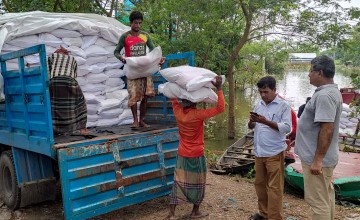
Read our 2023 annual report

Knowledge Hub
Kieran McConville has been cataloguing Concern’s work across the globe for over a decade, often reporting from scenes of humanitarian crisis. He’s witnessed near-heroic actions by countless colleagues in the face of extreme challenges, but his ongoing source of inspiration is an understated, middle-aged man who says he’s living out his boyhood dream.
At first sight, Zillur Rahman Chowdhury doesn’t look like your typical humanitarian.
Bespectacled and serious, with a neat mid-length haircut and a conservative short-sleeved shirt, he looks more like the traditional image of an accountant. So, when he tells me that he actually WAS an accountant, I laugh out loud.
“I studied for four years to be a chartered accountant,” he says, laughing too. “I completed the course, but didn’t go any further.” He subsequently took a shot at being a lawyer, but it turns out that wasn’t for him either.
They do say everything happens for a reason, and in this case accountancy and law’s loss was most definitely humanity’s gain. Because Zillur, whom I first met in 2017, has probably done more service for more people in the last 30 years than he could have in a century of number-crunching or litigation.

Zillur is an emergency guy, which is particularly useful in Bangladesh, a country that endures way more than its fair share of disaster.
Cyclones, landslides, and flooding are a fact of life (and death) in this country of 160-plus million people.
In fact, Concern’s first response to a major natural disaster came in the wake of Cyclone Bhola, which may have killed as many as 500,000 people when it made landfall on November 10 1970.
But it was a manmade crisis that confronted Zillur when he first joined Concern as a fresh-faced 22-year-old in October 1992.
Nearly a quarter of a million people had fled across the border from Myanmar into south-eastern Bangladesh, mostly Rohingya Muslims fleeing military activity. Because he was from the nearby Chittagong district, Zillur was well placed to help. “I recruited a team of local people, and we provided health and nutrition services to the people in need. We did that for three years.”
25 years later, that local knowledge would again be invaluable as another wave of displaced Rohingya - this time over a million people - came streaming into Cox’s Bazar while their villages across the border went up in flames.
It was there that I first saw Zillur in action, striding purposefully through the chaos, stopping occasionally to engage with the exhausted, injured, and traumatised men, women, and children who had come here to seek safety. By now a seasoned staff member, as soon as word of the crisis reached his office in Dhaka, he had immediately assembled a team of 14 people and they hit the road.



I love Concern because that is what they do, always in the hardest-to-reach places.
“A needs-assessment is very important”, he says. “You can’t do that sitting at a desk. You must go and observe for yourself. You must talk to the people you are supporting, talk to government officials, and talk to other organizations.”
Within days, the team was setting up emergency nutrition centres in the crowded, muddy hills south of Cox’s Bazar. Sadly, five years later that particular humanitarian response is still ongoing. But in the interim Zillur’s expanded team has provided crucial, often life-saving support to hundreds of thousands of people.
Across his career, Zillur has been involved in many emergency responses, big and small, right across Bangladesh.
Recently, photos started arriving on my desk from the north of the country, near the border with India, which had been slammed by the worst flooding in living memory. Some estimates put the number of people affected at 7 million - a truly mind-blowing number, even in the context of this water-ravaged nation. And there, riding a cargo boat piled high with sacks of aid, was Zillur, surrounded by flood waters.
“Since I was a boy in my village, I have always dreamed of working with the poorest of the poor,” he tells me over the phone. “Back then I didn’t know what an NGO was, but I saw how people were living and I wanted to work with them. I love Concern because that is what they do, always in the hardest-to-reach places.”

Regularly working 14 hours days, with long periods away from home and family, must take a toll though. Surely he gets tired sometimes? And all that human suffering must be very overwhelming?
“Tired? No! The people’s response to what we are doing makes me feel not tired. I am 52 now, but I am always ready, and I have a lot more to give. Yes, sometimes I do feel sad when I see bad things happen, but I have work to do. I always tell my team the same message when things are difficult - ‘this is not a job, this is a humanitarian mission. 9-5 does not work.’”
After a long, hard day on the humanitarian front lines, it’s always helpful to relax, and for Zillur and his team it’s no different. “In the evenings, if we have the chance, we’ll sit together and share food and tell stories and sing songs.”
So, if ever I’m having a bad day at my air-conditioned desk, Zillur Rahman is always my go-to source of inspiration. And the abiding image of him I have in my mind is from those chaotic early days of the Rohingya crisis in 2017.
Looking out across the sea of displaced people desperately clambering through the dirt and detritus of the world’s biggest refugee camp, I spot the stately figure of Zillur in the distance. It’s a thousand degrees, raining hard. As he sees me, he raises his arm in an enthusiastic wave, and unleashes a huge, beaming smile.
This truly is a man living the dream.
Other ways to help
Corporate support
Is your company interested in working together for a common cause?
Fundraise for Concern
From mountain trekking to marathon running, cake sales to table quizzes, there are lots of ways you can support our work.
Buy a gift
With an extensive range of alternative gifts, we have something to suit everybody.
Leave a gift in your will
Leave the world a better place with a life-changing legacy.
Volunteer with Concern
The lots of ways to get involved with our work as a volunteer
School fundraising
Without the generous support from schools, we wouldn't be able to do the work that we do.




